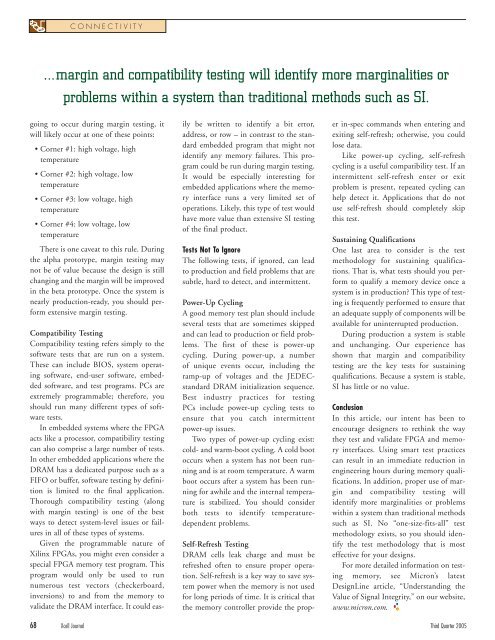Design Challenges: Avoiding the Pitfalls, winning the game - Xilinx
Design Challenges: Avoiding the Pitfalls, winning the game - Xilinx
Design Challenges: Avoiding the Pitfalls, winning the game - Xilinx
Create successful ePaper yourself
Turn your PDF publications into a flip-book with our unique Google optimized e-Paper software.
CONNECTIVITY<br />
...margin and compatibility testing will identify more marginalities or<br />
problems within a system than traditional methods such as SI.<br />
going to occur during margin testing, it<br />
will likely occur at one of <strong>the</strong>se points:<br />
• Corner #1: high voltage, high<br />
temperature<br />
• Corner #2: high voltage, low<br />
temperature<br />
• Corner #3: low voltage, high<br />
temperature<br />
• Corner #4: low voltage, low<br />
temperature<br />
There is one caveat to this rule. During<br />
<strong>the</strong> alpha prototype, margin testing may<br />
not be of value because <strong>the</strong> design is still<br />
changing and <strong>the</strong> margin will be improved<br />
in <strong>the</strong> beta prototype. Once <strong>the</strong> system is<br />
nearly production-ready, you should perform<br />
extensive margin testing.<br />
Compatibility Testing<br />
Compatibility testing refers simply to <strong>the</strong><br />
software tests that are run on a system.<br />
These can include BIOS, system operating<br />
software, end-user software, embedded<br />
software, and test programs. PCs are<br />
extremely programmable; <strong>the</strong>refore, you<br />
should run many different types of software<br />
tests.<br />
In embedded systems where <strong>the</strong> FPGA<br />
acts like a processor, compatibility testing<br />
can also comprise a large number of tests.<br />
In o<strong>the</strong>r embedded applications where <strong>the</strong><br />
DRAM has a dedicated purpose such as a<br />
FIFO or buffer, software testing by definition<br />
is limited to <strong>the</strong> final application.<br />
Thorough compatibility testing (along<br />
with margin testing) is one of <strong>the</strong> best<br />
ways to detect system-level issues or failures<br />
in all of <strong>the</strong>se types of systems.<br />
Given <strong>the</strong> programmable nature of<br />
<strong>Xilinx</strong> FPGAs, you might even consider a<br />
special FPGA memory test program. This<br />
program would only be used to run<br />
numerous test vectors (checkerboard,<br />
inversions) to and from <strong>the</strong> memory to<br />
validate <strong>the</strong> DRAM interface. It could eas-<br />
ily be written to identify a bit error,<br />
address, or row – in contrast to <strong>the</strong> standard<br />
embedded program that might not<br />
identify any memory failures. This program<br />
could be run during margin testing.<br />
It would be especially interesting for<br />
embedded applications where <strong>the</strong> memory<br />
interface runs a very limited set of<br />
operations. Likely, this type of test would<br />
have more value than extensive SI testing<br />
of <strong>the</strong> final product.<br />
Tests Not To Ignore<br />
The following tests, if ignored, can lead<br />
to production and field problems that are<br />
subtle, hard to detect, and intermittent.<br />
Power-Up Cycling<br />
A good memory test plan should include<br />
several tests that are sometimes skipped<br />
and can lead to production or field problems.<br />
The first of <strong>the</strong>se is power-up<br />
cycling. During power-up, a number<br />
of unique events occur, including <strong>the</strong><br />
ramp-up of voltages and <strong>the</strong> JEDECstandard<br />
DRAM initialization sequence.<br />
Best industry practices for testing<br />
PCs include power-up cycling tests to<br />
ensure that you catch intermittent<br />
power-up issues.<br />
Two types of power-up cycling exist:<br />
cold- and warm-boot cycling. A cold boot<br />
occurs when a system has not been running<br />
and is at room temperature. A warm<br />
boot occurs after a system has been running<br />
for awhile and <strong>the</strong> internal temperature<br />
is stabilized. You should consider<br />
both tests to identify temperaturedependent<br />
problems.<br />
Self-Refresh Testing<br />
DRAM cells leak charge and must be<br />
refreshed often to ensure proper operation.<br />
Self-refresh is a key way to save system<br />
power when <strong>the</strong> memory is not used<br />
for long periods of time. It is critical that<br />
<strong>the</strong> memory controller provide <strong>the</strong> prop-<br />
er in-spec commands when entering and<br />
exiting self-refresh; o<strong>the</strong>rwise, you could<br />
lose data.<br />
Like power-up cycling, self-refresh<br />
cycling is a useful compatibility test. If an<br />
intermittent self-refresh enter or exit<br />
problem is present, repeated cycling can<br />
help detect it. Applications that do not<br />
use self-refresh should completely skip<br />
this test.<br />
Sustaining Qualifications<br />
One last area to consider is <strong>the</strong> test<br />
methodology for sustaining qualifications.<br />
That is, what tests should you perform<br />
to qualify a memory device once a<br />
system is in production? This type of testing<br />
is frequently performed to ensure that<br />
an adequate supply of components will be<br />
available for uninterrupted production.<br />
During production a system is stable<br />
and unchanging. Our experience has<br />
shown that margin and compatibility<br />
testing are <strong>the</strong> key tests for sustaining<br />
qualifications. Because a system is stable,<br />
SI has little or no value.<br />
Conclusion<br />
In this article, our intent has been to<br />
encourage designers to rethink <strong>the</strong> way<br />
<strong>the</strong>y test and validate FPGA and memory<br />
interfaces. Using smart test practices<br />
can result in an immediate reduction in<br />
engineering hours during memory qualifications.<br />
In addition, proper use of margin<br />
and compatibility testing will<br />
identify more marginalities or problems<br />
within a system than traditional methods<br />
such as SI. No “one-size-fits-all” test<br />
methodology exists, so you should identify<br />
<strong>the</strong> test methodology that is most<br />
effective for your designs.<br />
For more detailed information on testing<br />
memory, see Micron’s latest<br />
<strong>Design</strong>Line article, “Understanding <strong>the</strong><br />
Value of Signal Integrity,” on our website,<br />
www.micron.com.<br />
68 Xcell Journal Third Quarter 2005

















